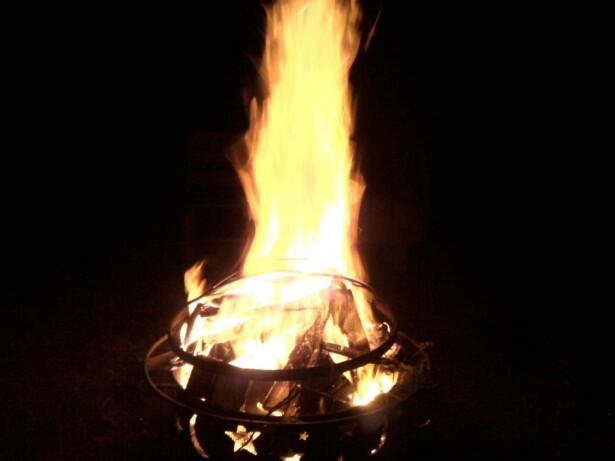|
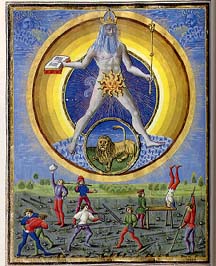
Greek Festival in the Gardens of Adonis: July 19
Summer Solstice: Ancient Ways of Marking Time
By the time of the New Stone Age (six to eight thousand years ago) there
are many signs that seasonal celebrations were at the center of community life. The farmers and seafarers whose lives depended
on the weather and seasons, naturally chose to gather together regularly to direct their appeals to the energies they believed
controlled the cycles of nature - birth, life, death and rebirth in which crops, animal and human all participate.
Ancient people used four primary ways of marking the solstices and equinoxes.
The first involved the creation of spot lighting effects on the walls of passages, chambers or caves. People who used this
technique often carved or painted symbols where they would be struck by a beam of light at sunrise or sunset on one of the
solstices or equinoxes. An example where this method was used would be Newgrange, an ancient chamber located in Ireland.
A second method involved measuring the shadow of an upright pillar usually
at noon. In temperate zones, the shadow is shortest at the summer solstice, and longest in midwinter. This technique was used
by Babylonians, Ionian Greeks, Chinese and Peruvians.
A third method used by Central American tribes required a specially prepared
ceremonial structure. Only at noon on the longest day of the year would the sun directly shine through a hole or tube in the
ceiling and onto a particular spot on the floor.
The fourth way to mark the solstices was to watch, from a fixed position,
where on the horizon the sun set over a period of years. The use of this last method was widespread throughout Europe, Asia,
and the Americas. Stonehenge, in England, incorporated this last method. The summer solstice sunrise is marked here. In Egypt,
the temple at Karnak also incorporated solstice alignments.
From China, the Book of Records describes instruction which "The Perfect
Emperor Yao (2254 BC.) gave to his astronomers to ascertain the solstices and equinoxes... and thereby fix the four seasons."
The summer solstice ceremony was the complement to the one in December. The winter festival was held to honor and energize
the celestial male, yang forces.
In order to counterbalance the natural predominance of yin that occurs
in that season, the summer festival was earthy, feminine, and yin in character so as to stimulate those forces. The summer
festival took place on the altar of the Earth, which was square to evoke the terrestrial forces. While the winter solstice's
sacrificial victim was burned so that smoke could rise to heaven, in summer the sacrifice was buried. -- Excerpts from the article, Summer Solstice, a web page from the American Spirit Newspaper

Toasting Immortality
On the eve of the longest day of the year, twist together wooden branches
into the shape of a man and place a piece of foil-wrapped bread inside it. Throw the man into a fiery pit, remove the toasted
bread from the charred remains, distribute among friends and eat.
Its the summer solstice Wicker Man ritual, and you wont be seeing it in
Martha Stewarts Living.
Witches of the pagan religion Wicca, however, regard...the Gregorian calendar
on which it is based as little more than random human constructs, and choose instead to be governed by solar, lunar and planetary
cycles. Summer solstice, when the sun hits the Tropic of Cancer and ascends to its highest point, is the longest day, and
shortest night, of the calendar year.
It is also one of the eight major holidays of witchcraft.
According to Reverend Marsha Smith, a spokesperson for the Salem-based
Witches League for Public Awareness, to practitioners of Wicca summer solstice is a time of heightened creativity, sensuality
and eroticism.
During the solstice, she says, the Wiccan Sun God reaches his highest power.
"Wicker Man" rituals re-enact the Sun Gods journey and the cycle of changing seasons. Wiccans believe that during the ritual
the Sun Gods spirit enters the bread, and that by eating it humans partake of his immortality.
"Because Wicca comes out of a Northern European experience, where winters
are awfully cold, people look forward to summer, when you can strip down and be outside," says Smith. It doesnt take a witch
to know that more sunlight means more exposed flesh, more hours to frolic and more opportunity to contemplate the joys of,
well, ah, procreation.
Summer solstice is also an occasion of transformation. "From winter to
summer solstice, the energy builds up. From summer to winter it wanes," Smith says. "Summer solstice is a very passionate
period, yet at the same time we acknowledge that its also when we start to slow down."
Along with the "Wicker Man" ritual, Reverend Smith also suggests leaping
over a bonfire as a "symbolic passing through the fires of purification." And, in a pinch, "A candle will suffice." -- Edited and excerpted from the article at LA Weekly
Midsummer: The Oak King and the Holly King
The Oak King defeats the Holly King on the longest day of the year.
The Holly King and the Oak King are part of Celtic mythology, and they
represent two sides to the Green Man, or Horned God.
They battle twice a year, once at Yule and once at Midsummer (Litha) to
see who would rule over the next half of the year. At Yule, the Oak King wins and at Litha, the Holly King is victorious.
In other words, the Oak King rules over the lighter half of the year, and the Holly King over the darker half. The change
from one to the other is a common theme for rituals at Yule, and also at Midsummer.
Another version of the Holly King and Oak King symbolism, is that they
do not directly switch places twice a year, but rather both live simultaneously. The Oak King is born at Yule, and his strength
grows through the spring, peaks at Beltane and then he weakens and dies at Samhain. The Holly King lives a reverse existence,
and is born at Midsummer, waxes more powerful through the summer and fall, to his peak at Samhain. His influence then lessens
until Beltane, when it is his turn to pass away. In this perspective, the two Kings enjoy a more intricate interplay of power
and is perhaps a better illustration of their duality. At any given time, they both exist but have varying levels of influence
throughout the year.
Either way, each King represents different ideas. The time of the Oak King
is for growth, development, healing, and new projects. The Holly King's time is for rest, reflection, and learning.
Midsummer has arrived, and if you're looking for more information on this
Sabbat, About's Pagan/Wiccan guide can help. You might want to make some traditional foods for a Solstice meal, or try your
hand at something crafty. Plenty of ritual ideas too. -- Excerpts from articles by Terri Paajanen, About.com's Pagan/Wiccan Guide
More Topics at About's Pagan/Wiccan Guide
Designed and erected by people who existed more than 5000 years ago, Stonehenge is still a traditional gathering place
on the Northern Hemisphere's longest day -- the Summer Solstice. Stonehenge is a mystery, one of several stone circle monuments
in Great Britain. The relationship and alignment of the standing stones to the sun's seasonal revolution appear to have been
designed to function either as some kind of astronomical calendar, or as a sacred ritual site honoring the sun. Whatever its
purpose to the ancients, the silent stones still wield an enormous power on tourists to Great Britain.
So much so that the English Heritage organization is going to be shutting the site down to visitors during the coming
years while renovations are made including diverting the highway and traffic away from its encroachment on the site itself.
Over time, the road and sidewalks have crept so close to the ancient remains that photographers and film crews seeking
to recapture the original mystery of the place have been hard put to keep modern automobiles and power lines out of the shots.
Similarly, the modern celebration of the Solstice has been the focus of a conflict of purpose from two fundamentally different
types of pilgrims. Spiritually-inclined Druids, Wiccans, neo-pagans, and new-agers feel quiet meditation and rituals
are the appropriate purpose for the sacred site's energies -- while others feel the occasion calls for dancing, chanting, and
a thunderous drum circle reminiscent of a Grateful Dead show. Public celebrations of the Solstice at Stonehenge were banned
until only two years ago due to a violent clash between celebrants and police in 1985.
Some consider the wide array of visitors to the site testimony to the need for people to draw together, but others feel
that most revelers have no understanding or respect for the sacred and magickal. Summer Solstice 2002 saw only eleven arrests
for substance offenses and a few of the truly irreverent who were ejected for such hijinx as climbing up the monument and
leaping from stone to stone.
--From a now-defunct English Heritage.org webpage
|
 |
|
|
|
 |
|
In August, heathens commorate the sacrifice made by Odin when he hung
himself from Yggdrassil, the World Tree, in his quest for the knowledge of life and death.
Celebrations of the Summer Solstice
The Summer Solstice is also known as: Alban Heflin, Alban Heruin, All-couples
day, Feast of Epona, Feast of St. John the Baptist, Feill-Sheathain, Gathering Day, Johannistag, Litha, Midsummer, Sonnwend,
Thing-Tide, Vestalia, etc.
"Solstice" is derived from two Latin words: "sol" meaning sun, and "sistere,"
to cause to stand still. This is because, as the summer solstice approaches, the noonday sun rises higher and higher in the
sky on each successive day. On the day of the solstice, it rises an imperceptible amount, compared to the day before. In this
sense, it "stands still."
Most societies in the Northern Hemisphere, ancient and modern, have celebrated
a festival on or close to Midsummer:
Ancient Celts: Druids, the priestly/professional/diplomatic corps in Celtic
countries, celebrated Alban Heruin ("Light of the Shore"). It was midway between the spring Equinox (Alban Eiler; "Light of
the Earth") and the fall Equinox (Alban Elfed; "Light of the Water"). "This midsummer festival celebrates the apex of Light,
sometimes symbolized in the crowning of the Oak King, God of the waxing year. At his crowning, the Oak King falls to his darker
aspect, the Holly King, God of the waning year..." The days following Alban Heruin form the waning part of the year because
the days become shorter.
Ancient China: Their summer solstice ceremony celebrated the earth, the
feminine, and the yin forces. It complemented the winter solstice, which celebrated the heavens, masculinity and yang forces.
Ancient Gaul: The Midsummer celebration was called Feast of Epona, named
after a mare goddess who personified fertility, sovereignty and agriculture. She was portrayed as a woman riding a mare.
Ancient Germanic, Slav and Celtic tribes in Europe: Ancient Pagans celebrated
Midsummer with bonfires. "It was the night of fire festivals and of love magic, of love oracles and divination. It had to
do with lovers and predictions, when pairs of lovers would jump through the luck-bringing flames..." It was believed that
the crops would grow as high as the couples were able to jump. Through the fire's power, "...maidens would find out about
their future husband, and spirits and demons were banished." Another function of bonfires was to generate sympathetic magic:
giving a boost to the sun's energy so that it would remain potent throughout the rest of the growing season and guarantee
a plentiful harvest.
Ancient Rome: The festival of Vestalia lasted from JUN-7 to JUN-15. It
was held in honor of the Roman Goddess of the hearth, Vesta. Married women were able to enter the shrine of Vesta during the
festival. At other times of the year, only the vestal virgins were permitted inside.
Ancient Sweden: A Midsummer tree was set up and decorated in each town.
The villagers danced around it. Women and girls would customarily bathe in the local river. This was a magical ritual, intended
to bring rain for the crops.
Essenes: This was a Jewish religious group active in Palestine during the
1st century CE. It was one of about 24 Jewish groups in the country -- the only one that used a solar calendar. Other Jewish
groups at the time included the Sadducees, Pharisees, Zealots, followers of John, and followers of Yeshua (Jesus). Archeologists
have found that the largest room of the ruins at Qumran (location of the Dead Sea Scrolls) appears to be a sun temple. The
room had been considered a dining room by earlier investigators, in spite of the presence of two altars at its eastern end.
At the time of the summer solstice, the rays of the setting sun shine at 286 degrees along the building's longitudinal axis,
and illuminate the eastern wall. The room is oriented at exactly the same angle as the Egyptian shrines dedicated to the sun.
Two ancient authorities -- the historian Josephus and the philosopher Filon of Alexandria -- had written that the Essenes
were sun worshipers. Until now, their opinion had been rejected by modern historians.
Native Americans: The Natchez tribe in the southern U.S. "worshiped the
sun and believed that their ruler was descended from him. Every summer they held a first fruits ceremony." Nobody was allowed
to harvest the corn until after the feast.
Males in the Hopi tribe dressed up as Kachinas - the dancing spirits of
rain and fertility who were messengers between humanity and the Gods. At Midsummer, the Kachinas were believed to leave the
villages to spend the next six months in the mountains, where they were believed to visit the dead underground and hold ceremonies
on their behalf.
Native Americans have created countless stone structures linked to equinoxes
and solstices. Many are still standing. One was called Calendar One by its modern-day finder. It is in a natural amphitheater
of about 20 acres in size in Vermont. From a stone enclosure in the center of the bowl, one can see a number of vertical rocks
and other markers around the edge of the bowl "At the summer solstice, the sun rose at the southern peak of the east ridge
and set at a notch at the southern end of the west ridge." The winter solstice and the equinoxes were similarly marked.
The Bighorn Medicine Wheel west of Sheridan, WY is perhaps the most famous
of the 40 or more similar "wheels" on the high plains area of the Rocky Mountains. Mostly are located in Canada. At Bighorn,
the center of a small cairn, that is external to the main wheel, lines up with the center of the wheel and the sun rising
at the summer equinox. Another similar sighting cairn provides a sighting for three dawn-rising stars: Aldebaran, Rigel and
Sirius. A third cairn lines up with fourth star: Fomalhaut. The term "medicine wheel" was coined by Europeans; it was a term
used to describe anything native that white people didn't understand.
Neopaganism: This is a group of religions which are attempted re-constructions
of ancient Pagan religions. Of these, Wicca is the most common; it is loosely based partly on ancient Celtic beliefs and practices.
Wiccans recognize eight seasonal days of celebration. Four are minor sabbats and occur at the two solstices and the two equinoxes.
The other are major sabbats which happen approximately halfway between an equinox and solstice. The summer solstice sabbat
is often called Midsummer or Litha. Wiccans may celebrate the sabbat on the evening before, at sunrise on the morning of the
solstice, or at the exact time of the astronomical event.
"Midsummer is the time when the sun reaches the peak of its power, the
earth is green and holds the promise of a bountiful harvest. The Mother Goddess is viewed as heavily pregnant, and the God
is at the apex of his manhood and is honored in his guise as the supreme sun."
It is a time for divination and healing rituals. Divining rods and wands
are traditionally cut at this time.
Prehistoric Europe: Many remains of ancient stone structures can be found
throughout Europe. Some date back many millennia BCE. Many appear to have religious/astronomical purposes; others are burial
tombs. These structures were built before writing was developed. One can only speculate on the significance of the summer
solstice to the builders. Perhaps the most famous of these structures is Stonehenge, a megalith monument on Salisbury Plain
in Wiltshire. It was built in three stages, between circa 3000 and 1500 BCE. "The circular bank and ditch, double circle of
'bluestones' (spotted dolerite), and circle of sarsen stones (some with white lintels), are concentric, and the main axis
is aligned on the midsummer sunrise--an orientation that was probably for ritual rather than scientific purposes. Four "station
stones" within the monument form a rectangle whose shorter side also points in the direction of the midsummer sunrise. -- Excerpts from the article at Religious Tolerance.org (where there are footnotes and links to other articles)
| Stone Henge |
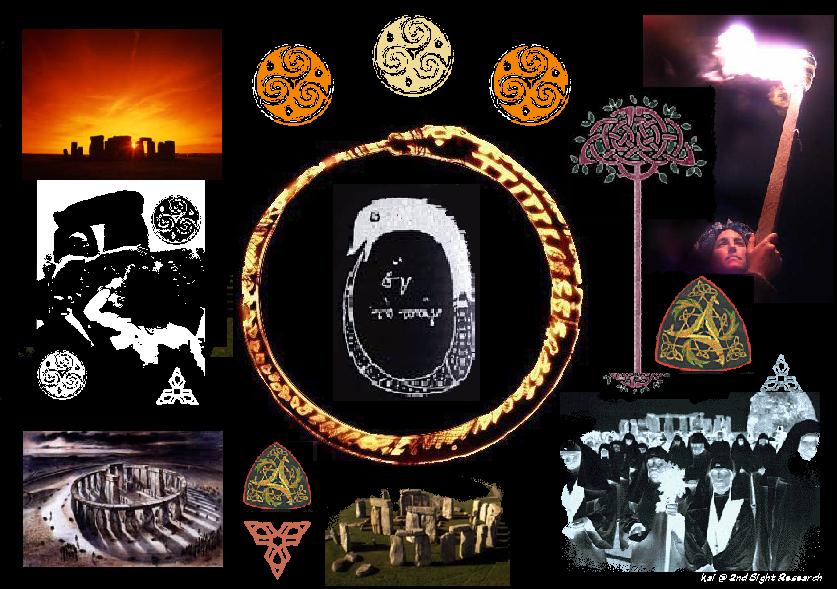
|
| Symbols of Ancient Britain |
Cosmic Link To Stone Circles
Stone Age people in Ireland appear to have built tombs based on a detailed
knowledge of how the Sun moves across the sky during the year. Tombs at the archaeological site of Loughcrew in County Meath
align with the rising Sun at the spring and autumn equinoxes.
The inside of the chambers are spectacularly illuminated by a shaft of
sunlight at dawn on these days, said Frank Prendergast of the Dublin Institute of Technology. It suggests settlers in the
area some 5 to 6,000 years ago knew the yearly cycle of the Sun and perhaps centred their lives around it.
Tombs found elsewhere in Ireland have been found to point towards the rising
Sun at the summer and spring solstices. At these times, the Sun reaches its most northerly and southerly points in the sky,
which can be easily observed from any place on Earth.
Why tomb builders wished to do this remains a mystery but it suggests the
Sun was at the heart of ritual and ceremonial practices of ancient people.
Professor Clive Ruggles, of the University of Leicester, believes the study
of astronomical alignments gives an insight into how people comprehended the world in the past. "The builders were not 'astronomers'
in the sense that we would mean it today, but celestial objects and cycles were important to them in keeping their own lives
in harmony with their world," he explained.
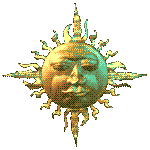
| The Fellowship of Earth, Moon, and Sky |
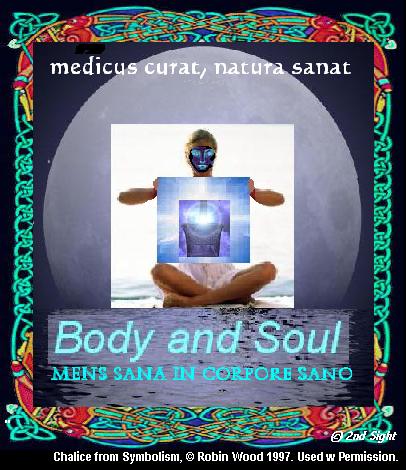
|
| Welcome and Mission Statement |
|
 |
|
|
|
